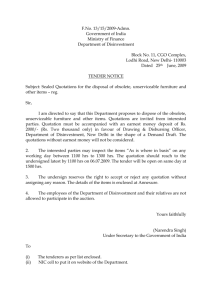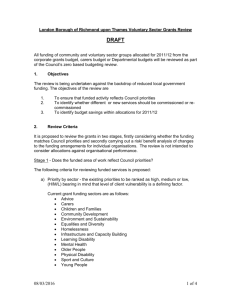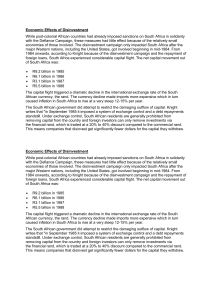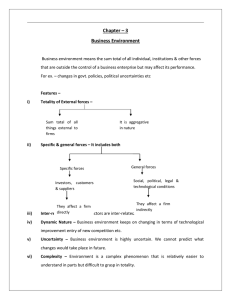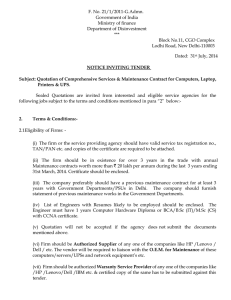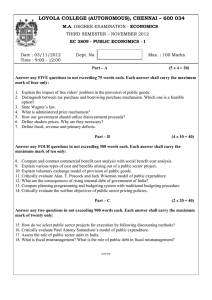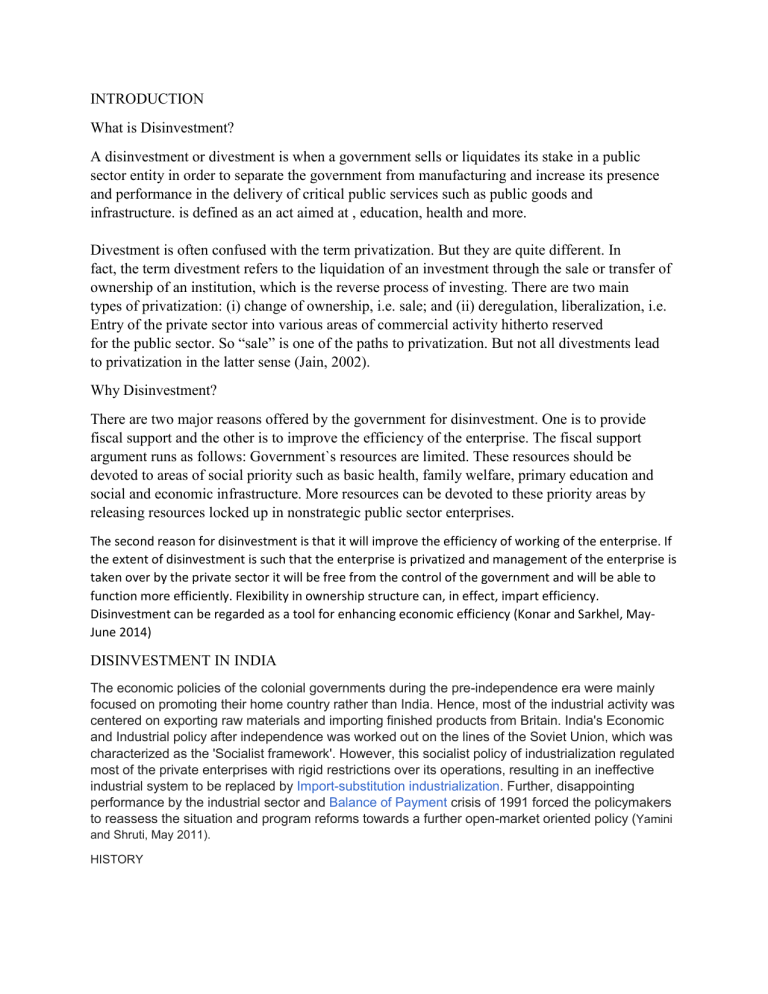
INTRODUCTION What is Disinvestment? A disinvestment or divestment is when a government sells or liquidates its stake in a public sector entity in order to separate the government from manufacturing and increase its presence and performance in the delivery of critical public services such as public goods and infrastructure. is defined as an act aimed at , education, health and more. Divestment is often confused with the term privatization. But they are quite different. In fact, the term divestment refers to the liquidation of an investment through the sale or transfer of ownership of an institution, which is the reverse process of investing. There are two main types of privatization: (i) change of ownership, i.e. sale; and (ii) deregulation, liberalization, i.e. Entry of the private sector into various areas of commercial activity hitherto reserved for the public sector. So “sale” is one of the paths to privatization. But not all divestments lead to privatization in the latter sense (Jain, 2002). Why Disinvestment? There are two major reasons offered by the government for disinvestment. One is to provide fiscal support and the other is to improve the efficiency of the enterprise. The fiscal support argument runs as follows: Government`s resources are limited. These resources should be devoted to areas of social priority such as basic health, family welfare, primary education and social and economic infrastructure. More resources can be devoted to these priority areas by releasing resources locked up in nonstrategic public sector enterprises. The second reason for disinvestment is that it will improve the efficiency of working of the enterprise. If the extent of disinvestment is such that the enterprise is privatized and management of the enterprise is taken over by the private sector it will be free from the control of the government and will be able to function more efficiently. Flexibility in ownership structure can, in effect, impart efficiency. Disinvestment can be regarded as a tool for enhancing economic efficiency (Konar and Sarkhel, MayJune 2014) DISINVESTMENT IN INDIA The economic policies of the colonial governments during the pre-independence era were mainly focused on promoting their home country rather than India. Hence, most of the industrial activity was centered on exporting raw materials and importing finished products from Britain. India's Economic and Industrial policy after independence was worked out on the lines of the Soviet Union, which was characterized as the 'Socialist framework'. However, this socialist policy of industrialization regulated most of the private enterprises with rigid restrictions over its operations, resulting in an ineffective industrial system to be replaced by Import-substitution industrialization. Further, disappointing performance by the industrial sector and Balance of Payment crisis of 1991 forced the policymakers to reassess the situation and program reforms towards a further open-market oriented policy (Yamini and Shruti, May 2011). HISTORY After India gained independence, the government adopted the Industrial Policy Resolution (IPR), 1956 with the objective of building sufficient industrial capacity for the nation (Government of India, 1956). The IPR noted that the state must play a ‘predominant and direct’ role in setting up new industrial undertakings in order to formulate a ‘socialistic pattern of society’ in India (Planning Commission of India, 2005). The IPR called for a three-fold classification of industrial sectors. Industries in Schedule-A of the Policy were reserved for the state. 1 Schedule-B of the IPR, covered industries where the government could set up units’ drugs and antibiotics etc. The remaining industries were left open to the private sector. After the IPR was adopted, the government established many CPSEs and their role in the economy expanded quickly. 2 The government’s total investment in CPSEs, which stood at INR 81 crore in 1956, had increased to INR 99,315 crore by 1990 (Department of Public Enterprises, 2005). By the early 1980s it was realized that production in public sector firms was significantly lower than their capacities. Some of the reasons for this trend are noted (Department of Public Enterprises, 1991): 1. 2. 3. 4. 5. Outmoded technologies Over employment Lower priority for fresh investments due to their presence in competitive sectors Poor project management High debt-to-equity ratio In 1991 India faced a financial crisis. The Gulf War in 1990 and the resulting oil shock added to the woes of balance of payments (Government of India, 1991a). The situation became worse with repatriation of thousands of Indians whose remittances had helped to manage the balance of payments (Ramesh, 2015). India’s foreign exchange reserves were sufficient enough for only two weeks of imports. Short term liquidity crisis had set in which could have resulted in medium and long term insolvency (Ramesh, 2015). As the economic situations worsened, the inflation rate soared as high as 10.31% by March 1991. The CPSEs role of ‘commanding the heights’ of the economy was also under stress. As on March 31, 1990 there were 244 CPSEs owned by the government with a total investment of INR 99,315 crore. Of these, 98 had accumulated losses in excess of INR 10,000 crore which accounted for 78% of the accumulated losses of all public enterprises (Department of Public Enterprises, 1991).4 Over employment and outdated technology were considered as the two major reasons for losses in CPSEs. For instance, there were 32 sick entities that the government had earlier taken over from the private sector to protect employment (Department of Public Enterprises, 1991). The Congress party won the tenth Lok Sabha election and in June 1991 it formed the government. The Common Minimum Program (CMP) of the newly elected government laid down its objectives. Although the challenges associated with public sector were acknowledged, the CMP emphasized the role of CPSEs as an important component of the Indian economy. Further, it resolved to restructure CPSEs, provide them corporate autonomy and take measures to rehabilitate sick units (Disinvestment Commission, 1997a). INTRODUCTION OF DISINVESTMENT IN INDIA Looking at the growing challenges of public sector firms, the government brought out a White paper on the Public Sector in March 1990. Later, the Department of Public Enterprises (DPE) submitted a note on the White Paper to the Cabinet Secretariat.9 The note for the first time conveyed the government’s intention to divest shares in favor of the general public and employees, but resolved to retain the public nature of the firm. However, the note mentioned that closure or divestment would be considered as a last resort, where turnaround was not possible (Public Accounts Committee, 1994). Disinvestment in India is a policy of the Government of India, wherein the Government liquidates its assets in the Public sector Enterprises partially or fully. The key engine in achieving growth in India during post-independence was played by Public Sector Enterprises (PSE). Among other responsibilities of PSE's post-independence, the social and developmental obligations of the nation were most important, which resulted in these units escaping competitive race. After the change of Government in 1991, among many economic reforms launched; privatization was one, which focused on the efforts required to be taken to curtail the fiscal burden of the state by reducing public sector borrowings and bring in fiscal austerity (Arun, 2010). While India adopted the path of gradual disinvestment, countries in the western world like Germany and the United Kingdom adopted whole-sale privatization to improve the efficiency of public enterprises. Possibly for this reason, the government preferred the use of the expression ‘disinvestment’ over privatization. Further, inference can be drawn from a parliamentary debate held in 2001, when Arun Shourie, the then Minister of Disinvestment clarified that the expression “disinvestment” was used because the government intended only piecemeal sale of minority shares (Lok Sabha, 2001a). Due to high levels of fiscal deficit, the government decided to raise resources through partial disinvestment in selected CPSEs (Public Accounts Committee, 1994). As a result, the Cabinet Committee on Political Affairs (CCPA) gave its approval to the decision of disinvestment and the first public announcement was made in the interim budget of FY 1991-92. Para 20 of the interim budget stated (Government of India, 1991a) DISINVESTMENT TIMELINE OF INDIA The timeline of disinvestment in India starts from 1991 and The history can be divided into four broad phases based on the different government regimes till, 2020. Phase 1 (1991-1999): This was the first time the idea of disinvestment was conceptualized in India. It was largely a result of poor performance of CPSEs and a fiscal and balance of payment crisis that hit India in 1991. Economic stress ushered several reforms in India and disinvestment was one of them. Although there was no ‘policy document’ on disinvestment, it evolved through union budget speeches. The initial phase was marked with gradual reduction in government holding through sale of minority shares and no privatization. For the major portion of this phase (from 1991-1996) shares were sold using the ‘auction route’ and prices of shares were fixed by the Core Group based on the advice of merchant bankers. Between 1996 and 1999 few GDR issues in telecom firms and cross holding in oil majors were undertaken. It was only post August 1996, that the expertise of the DC was available to the government, which gave lot of impetus to strategic deals. However, by then political instability had set in which possibly affected the decisions. In sum, within a duration of eight years, an average 8.87% shares were diluted in 39 CPSEs with no transfer of control to private parties. Also, India had just begun moving away from years of state driven capitalism, therefore, any sudden measure like privatization could have had negative political consequences. As pointed out by the DC, that success of Indian disinvestment program hinged on political will and consensus. Further, public suffered from misconceptions about disinvestment which needed to be dispelled to build credibility of the disinvestment program. However, it is not clear whether government took measures to address the problem of perception and ensure wider public participation. Although it was the government’s first attempt to use disinvestment to address the problems of public sector firms, one of the main aims was to raise resources by selling shares. Despite recommendations from expert committees like Rangarajan committee and DC to de-link disinvestment program and budgetary targets, this correlation gained momentum. Despite several efforts, the target amount could not be achieved due to poor market conditions. Total budgetary target set for this duration was INR 34,300 crore, but less than half of it (INR 16,809 crore) was realized. Possibly due to widening fiscal deficit and growing losses in public firms, government yielded to short term measures like diluting minority shares of profit making companies and disinvestment of oil companies through cross holding. On one hand the phase did not see any privatization, on the other, investment in public firms soared. Interestingly, this was against the intention of the government to reduce budgetary support which was one of the main concerns of the public sector. Towards the end of FY 1999, investment in CPSE stood at INR 2,39,167 crore against INR 99,315 crore as on March 31, 1990. Steps were taken to strengthen the operational autonomy and efficiency of CPSEs – several MoUs were signed between the government and the firms since 1991. Constitution of the DC was a milestone in this phase which reflected government’s intention to promote disinvestment. While the commission had only recommendatory powers unlike a body like Treuhandanstalt in Germany which implemented privatization, DC institutionalized disinvestment process in India to some extent from 1996 to 1999 (Ganesh, 2001).46 For the first time a systematic procedure was followed where firms selected for disinvestment were referred to a separate body like DC which provided detailed recommendations based on economic rationale. Although the DC was under the purview of the government, it did not refrain from highlighting problems like, slow progress on decisions and government’s ad-hoc steps misaligned with the long term disinvestment strategy. Possibly such observations had consequences and ultimately lead to the dilution of its powers in January 1998. The commission’s term expired in November 1999. Phase 2 (1999-2004): Similar to the first phase, the second phase began with its own set of economic challenges. The East Asia Economic crisis in 1998 affected demand for Indian exports and services. The geopolitical conditions in the sub-continent were unstable and India’s nuclear tests in 1998 lead to trade sanctions from countries like the U.S. and Japan. In the middle of 1999, war broke out with Pakistan in Kashmir. The fiscal deficit stood at 5.9 % of the Gross Domestic Product (GDP) and the economy was facing both lower food and industrial production (Government of India, 1999). As India entered the Phase 2 of disinvestment reforms, the economy had started its expansion and GDP growth rates rose from 3.84% in 2000 to 7.9% in 2004. The government promoted a policy of strategic sales which increased private sector participation in major industries. Many of the firms that underwent strategic sales were in sectors such as, telecommunications, metals (aluminum and zinc), petrochemicals, automobiles, and fertilizers. Although the announcement on privatization was made during the immediately previous term of the NDA government, which might have had a symbolic effect, execution took place only during Phase 2. As the NDA government assumed power for the second time in 1999, several crucial policy decisions were taken. To begin with, a dedicated disinvestment department was created to expedite the process of privatization, which was later elevated to the status of ministry. Also, for the first time, the President during the address to the joint session of Parliament explicitly announced that disinvestment of public sector firms in non-strategic sectors was no longer a choice but an ‘imperative’ (Department of Disinvestment, Ministry of Finance, 2003). Other policy decisions included revival of the Disinvestment Commission which recommended 17 new firms for privatization, but only some of those firms recommended by the previous commission were privatized. A total of 12 strategic disinvestment transactions were carried out between 1999 and 2004 of which control and management of the company was transferred to the private sector in 10 firms. Despite some successful privatization deals where majority stake was sold, government could realize INR 24,619 crore against the target of INR 58,500 crore fixed for the period between 1999 and 2004. To bring transparency and accountability, the government introduced India’s first disinvestment procedure manual which has been improved upon over the phases. Further, the government announced the setting up of a ‘disinvestment proceeds fund’ to utilize the proceeds for targeted social sector reforms and generation of employment opportunities, however, no such fund was created. In the absence of such mechanism, it was not possible to map the utilization of proceeds to the targeted expenditure like social sector or retiring of public debt (Comptroller and Auditor General of India, 2006). As privatization was new to the Indian political economy and given its sensitive nature, Phase 2 was mired with controversies, political opposition and litigations. One of the repeated allegations the government had to face was undervaluation of firms and selling the national assets at a throw away price. Besides, the government argued that unlike the erroneous policy of minority stake sale in the past, privatization in non-strategic sectors was necessary to revive economic efficiency of the public sector firms. Some relief came in 2001, when the Supreme Court in the BALCO deal held that the courts cannot interfere in economic policy matters like disinvestment. Similarly, on the aspect of valuation, the apex court took the position that unless there was an error in complying with the valuation procedures, it did not have jurisdiction to question the facts of valuation. Apprehension of job loss was associated with most of the deals, and major labor unrest broke out during the sale of BALCO, when almost 7000 workers went on a strike for 67 days. But the Supreme Court’s decision clarified that neither transfer of management control to private players can be equated with job loss nor the right of job protection can prohibit government to disinvest a firm. However, to address the concern of job loss, every strategic deal imposed a contractual prohibition on the strategic partners not to retrench workforce for one year from the date of execution of agreement, unless certain conditions were met. While Phase 2 did not witness retrenchment due to privatization, the government declared several VRS packages. As on March 2005, 5.53 lakh employees had opted for VRS (Department of Public Enterprises, 2005). The Supreme Court’s decision in BALCO was expected to pave a way for future strategic decisions. However, in 2003, the government had to miss the opportunity to disinvest HPCL and BPCL when the apex court held that a public sector firm created out of nationalization under a statute cannot be privatized, unless the concerned statute was amended through parliamentary nod. Another highlight of Phase 2 was the audit observations of the CAG. From preliminary reports in MFIL and BALCO deal, to final report on the strategic deals which was released in 2006 during Phase 3, the CAG flagged objections on multiple grounds like, improper valuation of firms due to non-consideration of surplus assets (land and building), irregularity in appointment of intermediaries, non-segregation of core and non-core assets before disinvestment. As witnessed in the case of VSNL where surplus 770 acres of land was not demerged before privatization, the dispute dragged on and was settled only in 2019 after a gap of 17 years. Although the objections fueled political controversies, they provided key learnings for the future disinvestment exercise (Sridhar, 2006). Although Phase 2 had its own share of problems and controversies, some of which continued for more than a decade, this is the only phase in the history of Indian disinvestment, when privatization was carried out. The ‘Economic Survey’ of 2019-20 stated that over the years, the productivity of these privatized firms improved significantly which substantiates the economic rationale behind privatization (Ministry of Finance, Government of India, 2020). Phase 3 (2004-2014): The Congress party and its coalition partners (collectively called the UPA) formed the government with support from the Communist parties. Dr. Manmohan Singh was appointed the Prime Minister. The UPA government had come to power at a time when the economic situation had started to improve — the GDP growth rate had increased to 7.9% in 2003-04 from a low of 3.8% in 19992000. In its first term, the UPA’s economic policy focus was on redistribution of wealth through social sector schemes (Government of India, 2004). When the government was formed, the members of the UPA had formulated the National Common Minimum Programme (NCMP). As far as disinvestment was concerned, there were five main objectives (Department of Disinvestment, Ministry of Finance, 2007): 1. Full managerial and commercial autonomy would be given to profitable CPSEs. 2. Privatization would be considered only on a case to case basis. Generally, profit making CPSEs and Navaratna CPSEs would not be privatized. They would remain within the public sector. 3. Loss making companies to be sold or closed. 4. Revenues from privatization would be used for designated social sector schemes 5. Public sector companies would be encouraged to enter the capital markets. All the proposals of the NCMP were adopted without change in the Budget of 2004- 05. The government was criticized for not having a formal policy on disinvestment (as opposed to the NCMP). The Lok Sabha Standing Committee on Finance recommended that a White Paper should be issued to bring out and clarify the government’s policy on disinvestment (Lok Sabha, 2005). This White Paper was released in July 2007 and it reiterated the policy positions taken by the NCMP. The CPSE’s public character was reinforced by the government investing more money into CPSEs. Total investments in CPSEs had increased from INR 3,49,209 crore in March 2004 to INR 5,28,951 crore in March 2009. By March 2014, these investments stood at INR 9,92,971 crore. The total equity infusion in CPSEs by the government between the years 2004-2009 was INR 77,932 crore and loans worth INR 14,448 crores were advanced to CPSEs by the government during the same period. In the first term of the UPA, all of the Budget Speeches carried details on how much money the government would invest in the public sector by means of equity infusions and loans. These details were not covered in any of the Budget Speeches during Phase 2. This practice of reporting investments in CPSEs stopped after 2009 i.e. after the first term of UPA ended. While the BIFR was deciding on the restructuring mechanism for sick companies, the government set up the Bureau for Reconstruction of Public Sector Enterprises (BRPSE) in December 2004 as a part-time advisory body to address the task of strengthening, modernization, reviving, and restructuring of CPSEs. It was an inter-ministerial body which took decisions after consultations and its decisions did not have the force of law unlike those of BIFR. The threshold for declaring ‘sickness’ under the Sick Industrial Companies Act was losses exceeding the company’s entire net worth in the preceding financial year. This definition had been criticized for triggering corrective actions at a very late stage of sickness (Ravi, 2015). Whereas the BRPSE had a lower threshold for sickness which considered restructuring proposals for companies which had losses in any financial year of more than 50% of its average net worth during the four years immediately preceding it. The directors of the company were obligated to file an application to BIFR if the definition of sickness was met, but in case of BRPSE the reference was made by the administrative ministry of the CPSE. However, the government clarified that the processes in BIFR and BRPSE were to run separately and there were no linkages between the two (Standing Committee on Industry, Rajya Sabha, 2005). Another important feature of this period was the setting up of the National Investment Fund. In December 2005, the National Investment Fund (NIF) was set up to act as a fund to collect proceeds from disinvestment of CPSEs. The money obtained from the fund was to be used to support certain specific social sector programs that were run by the central government. The fund had the following characteristics: 1. The fund was constituted to receive proceeds from disinvestments. 2. It would then contribute 75% of its income towards specific targeted social sector programs in education, health and employment. 3. The remaining 25% was to be spent on meeting capital investment requirements of profitable and revivable CPSEs. The money would be spent on enlarging the capital base for CPSEs and finance their expansion and diversification. The NIF was restructured twice. In the year 2009, there was a change in the policy of utilization of disinvestment proceeds. This one-time exception, in operation from year 2009 till 2013, was made where the proceeds from the disinvestments were to be used for select social sector schemes allocated by the Planning Commission and Department of Expenditure. The NIF was further restructured on 17th January 2013 and the policy was revised. The NIF continues to exist even after the UPA lost power in 2014. As recently as 2019, the Union Budget credited INR 2000 crore towards the NIF. In the first term of the UPA, there was a reluctance to undertake large disinvestments. Only four major disinvestment transactions took place. But two factors lead to the increase in disinvestments in the second term of UPA. Firstly, the Communist parties withdrew support to UPA in 2008 over the issue of the nuclear deal with the United States. Secondly, in September 2008, the bankruptcy of the US investment bank Lehman Brothers signaled the start of the Great Recession. While the Indian economy was not as badly affected as some of the other leading economies of the world, it did have a significant impact on public finance. Fiscal deficit had started to increase compared to previous years. The government needed to raise more funds than before. Hence these proved to be major factors in why most disinvestments of Phase 3 were carried out between the years 2009-2014. One of the goals of the government in this phase was to encourage CPSEs to access capital markets and to meet the increased minimum public shareholding requirement. As a result, there was a pivot towards minority stake sales. This resulted in two new methods of disinvestment: offer for sale through the stock exchange (OFS-SE) and exchange traded funds (ETFs). There was also an increase in the number of public offers in this period, as well as on the use of buybacks as a method of disinvestment. Overall, this phase saw no strategic sales. The target of INR 1,93,000 crore was not realized. Instead, the government raised INR 1,14,045 crore. Phase 4 (2014-2020): Towards the end of FY14, India had witnessed several economic challenges. The fiscal deficit stood at 4.6% of gross domestic product (Ministry of Finance, Government of India, 2014). Growth rate stood at 6.4% in 2013-14. Also the disinvestment target could not be realized in FY14. As a result, the government had to cut INR 79,790 crore from the budgeted plan expenditure of INR 5,55,532 crore for the said FY. Public sector also underperformed during this period. Out of total 234 firms, 71 firms incurred a loss of INR 20,055 crore whereas the 163 firms booked a profit of INR 149,164 crore. Table 19 shows the declining financial ratios of CPSEs in the past six years to substantiate their poor performance. As the NDA government was formed in 2014, there were initial speculations about the revival of strategic disinvestment. However, the government carried out minority stake sale in the first FY and decision was taken to retain control over the CPSEs. It was in 2016, the government issued the new disinvestment policy which clearly laid down its two pronged approach i.e., strategic sale and minority sale.139 Also, the cabinet approved the new strategic disinvestment procedure. To initiate the process of strategic sale, the NITI Aayog, which was set up in January, 2015 to succeed the Planning Commission, was given the mandate to identify the firms and submit the list of firms to DOD. During this phase, the word ‘disinvestment’ was dropped from the name of DOD, and the department was rechristened as DIPAM. Government expects DIPAM to manage its investments in the CPSEs in a better manner and obtain higher returns. Initially the NITI Aayog selected the firms for strategic sale, and DIPAM executed the disinvestment process. But in 2019, the role of DIPAM was further expanded and it was authorized to give recommendations to the IMG on selection of firms for strategic disinvestment. Phase 4 saw measures to expedite the process of decision making in strategic sale. For instance, a new body called as AM, headed by the Finance Minister, was created to take crucial decisions on the firms which have already received CCEA’s ‘in-principle’ approval. This was done to avoid CCEA’s involvement at every step. Later in 2019, the AM was vested with more powers to decide on issues like, quantum of shares to be sold, final pricing, etc. In the past six years, the CCEA approved a total of 34 firms for strategic disinvestment, including both profit and loss making entities. As most of the strategic sale transactions are still in process, there could be several reasons for the delay like, financial position of the firms, lack of interest from buyers, litigation, adverse market conditions, and the ongoing pandemic. Also, unlike the NDA government in Phase 2 which clearly stated privatization as part of its disinvestment policy, the incumbent government adopted a cautious approach. This can be inferred from measures like strategic sale of CPSEs to other government owned firms and decision to reduce government equity below 51% in select CPSEs, but without transfer of management control. Another reason could be the past experience of controversies associated with the privatization (Rai, 2019). This phase witnessed a constant push for sale of minority stake. One of the reasons for this could be an increase in the minimum public float in listed public sector firms from 10% to 25%. To meet this, OFS through stock exchange has been a preferred method of disinvestment. Although there have been multiple OFS transactions, several listed CPSEs still fail to meet the MPS requirement. As a result, the minimum public float norms are yet to come into operation and the deadline for meeting the requirement was extended repeatedly. Other methods of minority sale included ETF and buyback. Although ETF was introduced in the previous phase, it was frequently used in Phase 4. Considering good response from the buyers, the government launched Bharat 22 ETF in 2018. Even buyback saw a surge after it was made compulsory under the new capital restructuring norms. Between FY 15-20, a total of 36 buy-back transactions took place contributing to proceeds of INR 40,3549 crore. However, the average change in government’s equity is only 0.64%. During this phase, the government expanded the scope of disinvestment and added innovative avenues to augment disinvestment proceeds like, sale of enemy shares, asset monetization policy which included sale of non-core assets of firms identified for strategic sale and sale of strategic holdings in SUUTI. Although these options may not reduce government’s equity in public sector firms, the proceeds have been brought within the ambit of disinvestment, possibly to meet the fiscal deficit. In addition to carrying out strategic and minority sale, DIPAM has been authorized to carry out these transactions. Overall Phase 4 witnessed several announcements of big ticket strategic disinvestment ‘signaling’ privatization. However, there have been only strategic sales between CPSEs. The government managed to raise INR 3,05,357 crores between FY 15 to 20, on an average, the government sold 7.28% of total shares and the average reduction in government equity has been around 5.84%. Out of the total disinvestment proceeds, 78% have come from sale of minority stake using methods like public offer, ETF and buyback. Out of these methods, public offer and ETF have contributed to 32% of the disinvestment proceeds. Although some of these methods have contributed to disinvestment proceeds, there has not been commensurate reduction in the government’s equity. Moreover, this is not in sync with the government’s intention to exit from the non-strategic businesses for efficient utilization of the public resources. Given the political majority the incumbent government enjoys; further privatization could take place in the remaining term of the government which ends in 2024. DISINVESTMENT IN INDIA: A NEED OF AN HOUR? New Economic Policy 1991 argued the need of privatizing /divesting the public sector of the nation. It says that they should be privatized for many reasons. The cornerstone of the case for disinvestment / Privatization is that private ownership leads to better use of resources and their more efficient allocation. Nicholas Stern emphasizes growth driven by private sector. ‘Not only is the private sector the main engine of aggregate growth, it is also the main provider of economic activity for poor people. Of the 1.2 billion people in the world who live on less than $1 a day, only a minute fraction work in the public sector. The growth of the private sector is therefore vital to reduction of poverty’. Comparisons between PE (Price−earnings) ratios of public and private firms are revealing. In majority cases as seen in the below table, the private firms outperform the public firms. The Central Government has been facing a debt crisis, and cannot continue with its subsidies to loss−incurring enterprises. There are other urgent needs like education, transport, health and other services. Since 1992−93, government has spent around 35,000 crores for revival and restructuring of PSEs. In1991, out of 237 operating enterprises ,102 were loss−incurring and sick enterprises. The number increased to 111 in 2001 out operating units. The accumulated loss of PSEs amounted to 52,551 crores in 2001. Moreover, less than two per cent of India’s workforce is employed in the PSEs. The argument put forward by some is that why should more than 98 percent of Indian workers and 100 percent of Indian tax payers and consumers be made to suffer for the sake of few. Considering the need of the hour, the pro−privatization lobby in the government circle has strongly proposed that privatization would put an end to all wastage of money in subsidies to PSEs and let companies prosper in the private hands. It is argued that protectionism may help PSEs for a short period, but it is no solution. It has negative effects on the economy as a whole. Protectionism will stifle the global competitiveness of Indian industries, in fact, with the new WTO regime, the government will be severely restricted in its ability to artificially protect any industry from competition at expense of consumers. One basis rational for privatization in the concept that private ownership leads to better use of resources and their more efficient allocation. Another need for adoption for privatization policy around the globe has been the inability of the Governments to raise high taxes, pursue deficit / inflationary financing and the development of money markets and private entrepreneurship. Further, technology and W.T.O. commitments have made the world a global village and unless industries, including PSEs do not quickly restructure, they would not be able to survive. Economists and researchers give various other needs for privatization/disinvestment. One of the most valid arguments given is that PSU’s have been characterized by low productivity, unsatisfactory quality of goods, excessive manpower utilization, inadequate human resource development and low rate of return on capital. Hence, divestment indeed is a good idea provided it is coupled with share buyback, but still we can’t predict its unforeseeable consequences, its long term effects. These arguments do favor the disinvestment as the need (Vikas, 2015). DISINVESTMENT IN INDIA: A PUBLIC POLICY FAILURE? Some arguments given in favor of disinvestment and considering them as the need of the hour have widely criticized and tagged as the compulsions on the government to divest the crown jewels of the nation. Indian disinvestment programme was an offshoot of an unprecedented macroeconomic crisis during 1990-91. This was mainly due to the large imbalances on internal and external account, making the economy highly vulnerable. There was worsening of the fiscal deficit from 1985-86 onwards due to a steady increase in government expenditure, particularly non-plan expenditure. The fiscal deficit of the central government rose to 8.4 per cent of Gross Domestic Product (GDP) in 1990-91, an all-time high. Further, the public debt to GDP ratio increased in 1980s and was 62.9 per cent in 1990-91. This, coupled with the Gulf War in 1990-91 and the consequent rise of oil prices, further worsened the fiscal crisis. Erosion of confidence in the government's ability to manage the economy led to a drying up of the market for external commercial loans. The net outflow of non-resident Indian deposits also significantly added to the balance of payment crisis. Due to the deteriorating balance of payments situation, the Reserve Bank of India resorted to stringent contractionary measures, through monetary and credit policy instruments. Notwithstanding these measures and large drawings from the International Monetary Fund in July 1990 and January 1991, there was a sharp reduction in the foreign exchange reserves during 1990-91. In July 1991, the foreign exchange of about US$ 1 billion was barely sufficient to finance imports for two weeks. With inflation accelerating to almost 14 per cent-high by Indian standards-and depletion of foreign serves, the country was on the verge of default with respect to its external payments liability. (Naib,2004) It was argued that the main causes of this fiscal crisis was the failure of the public sector to generate investible resources and unbridled non-plan government expenditure. This situation arose because of a variety of problems such as an inefficient, high cost and non-competitive industrial structure, and serious infrastructure-related bottlenecks. It was believed that microeconomic rigidities induced by industrial, trade, public sector and foreign investment policies had constrained choices, apart from protecting Indian enterprises from internal and external competition. Hence it was considered compulsory to divest the PSEs to overcome these variety of problems. In other words, the study finds no option than a compulsion to to divest even the profit making PSEs was available with the government. A number of problems and issues have bedeviled the disinvestment process. The number of bidders for equity has been small not only in the case of financially weak PSUs, but also in that of better performing PSUs. Besides, the government has often compelled financial institutions, UTI and other mutual funds to purchase the equity which was being unloaded through disinvestment. These organizations have not been very enthusiastic in listing and trading of shares purchased by them as it would reduce their control over PSUs. Instances of insider trading of shares by them have also come to light. All this has led to low valuation or underpricing of equity. Further, in many cases, disinvestment has not really changed the ownership of PSUs, as the government has retained a majority stake in them. An important fact that needs to be remembered in the context of divestment is that the equity in PSUs essentially belongs to the people. Thus, several independent commentators have maintained that in the absence of wider national consensus, a mere government decision to disinvest is not enough to carry out the sale of people assets. Inadequate information about PSUs has impeded free, competitive and efficient bidding of shares, and a free trading of those shares. Also, since the PSUs do not benefit monetarily from disinvestment, they have been reluctant to prepare and distribute prospectuses. This has in turn prevented the disinvestment process from being completely open and transparent. Lastly, to the extent that the sale of government equity in PSUs is to the Indian private sector, there is no decline in national wealth. But the sale of such equity to foreign companies has far more serious implications relating to national wealth, control and power, particularly if the equity is sold below the correct price! If the disinvestment policy is to be in wider public interests, it is necessary to examine systematically, issues such as - the correct valuation of shares, the crowding out possibility, the appropriate use of disinvestment proceeds and the institutional and other prerequisites. CONCLUSION AND SUGGESTIONS: Having the aim to fulfill the needs of the hour the disinvestment policy was introduced with the objective to broad base equity, improve management practices, and raise resources for the enterprise; it would make the units stronger through better management practices, wider dispersal of interest, and initiation of the private management practices. The proceedings of disinvestment had started with the budget 1991–1992, to divest 20 % of government equity in the select PSEs in favor of investors, mutual funds, and workers. During the initial period, the government continued to disinvest 3–5 % of the equity in different non-strategic PSEs every year. This disinvestment or more popularly the minority privatization was more governed by the compulsion of financing the fiscal deficit of the government (Jain,Yadav and Gupta 2014) This provided stronger commercial consideration in response to normal shareholders’ expectations. In pursuant of the policies of the United Front government, a Disinvestment Commission was set up in 1996. It is also observed that the disinvestment proceeds were totally negligible and insignificant in relation to fiscal deficit during the period 1991-2004. Below mentioned table reveals that the amount of earnings realized through CPSE disinvestment is Rs. 45,038 core, while the total fiscal deficit since 1991-92 to 2003-04 has been to the tune of Rs. 11,87,310 crores. This means that on an average only 3.8 percent of the fiscal deficit has been financed through the divestiture being as low as 0.60 percent in 1995-96 and 0 percent in 1993-94. Therefore, one can conclude that the current levels of disinvestment are of limited effect for closing the fiscal deficit and the claim that the disinvestment is necessary to reduce the fiscal deficit has practically turned to be ridiculous. If the needs are to be analyzed the study finds that, of course, overall efficiency of PSEs has increased to some extent, as the number of profit-making PSEs has gone up over time. Table mentioned below reveals as on 31st March, 1985, there were 207 working units of PSEs, of which only 113 units (i.e.55 per cent) were identified as profit-making while 92 (i.e. 44 percent) were loss-making units. As on 31st March, 1991, out of 236 units, only 123 were identified as profitmaking while 111 were loss-making units. But in the year 2009-10, the number of profit-making units increases to 158, which is 73 percent of total operating PSEs, as a result of which the number of loss-making units have come down to 59 units„ i.e. 27 per cent. From the discussion. it is apparent that the percentage of profit making PSEs is increasing day by day, and it no doubt gives a ray of hope. It shows some of the needs regarding efficiency of PSEs have been realized which is evident from the following table: if we consider the impact of economic reforms as a whole since 1991, we shall rather be disappointed, as the tall promises were seldom put into action. So far the GDP has continued to grow since 1991-92 at the same rate (5.7%) as it did during the previous decade. The proposition that poverty began to decline in response to the reforms in 1991 is not also sustainable as the proportion of population living below poverty line has started to come down much earlier, i.e. since 1973-74. If the trends in employment are taken into account it is seen that the share of organized sector in total workforce has declined from 8.7% to 8.1%. The share of self employed in total workforce has also declined from 56.5% to 51.7% and only that of casual wage employment has gone up from 28.2% to 33.2%. Trends in income distribution during pre-reform and post-reform also reveal, rather alarmingly, that the disinvestment or privatization in its present form is perhaps not suitable for a country like ours where nearly 50% people are still below poverty line. Inequality in the distribution of value added between wages and profits - all have been widened in 25 years since 1974-75. In view of all these, a doubt and dissatisfaction has been raised in the mind of public about disinvestment or privatization as the objectives of disinvestment were diluted and it was more a compulsion than a need. RECOMMENDATIONS Disinvestment has not yielded desired results in majority of dimensions; it may be virtually due to variety of problems faced by PSEs even after disinvestment, such as inefficient, high cost and noncompetitive industrial structure, operational inefficiency due to high governmental interference, environment restrictions (delegation of operational and functional autonomy to the managers through performance contracts), less proportion of disinvestment and capital market discipline. Therefore, it is recommended that the government henceforth should aim for strategic disinvestment; as small and modest sizes of disinvestment are not likely to be fruitful. The government’s intervention in the operational functioning and managerial decision-making should be a matter of last resort. Similar recommendations have been made by D Souza and Megginson (1999); they suggest for complete privatization with both ownership and control of the enterprise being passed on to private participants. The government should adopt a selective policy in the case of closing the loss-incurring PSEs. It is understandable that for social reasons, the government normally finds difficult to close the sick/loss-incurring PSEs. The government may sell such PSEs to private sector. For the purpose, it may invite tenders from the private sector. Obviously, in some cases, it may be very difficult to sell them at positive price. Since, the condition would be to run them in future; it may sell them with minimum negative tender price. The payment of one lump sum should be preferred to have operating losses year after year. This needs to be experimented as has been recommended in earlier works of Patnaik (2006) and Gupta (2005). They emphasize that the loss-incurring PSE can be in such a poor shape and saddled with such large obligations that nobody in the private sector is willing to pay money, then government should permit negative bids in auction (where government pays someone to take the company off its hands) as followed in Germany. (Rastogi, Shukla 4, Oct - Dec 2013) Since independence PSUs are the main pillars of the Indian economy, which includes central, state and local bodies. It is due to many reasons cited above the performance of PSUs was poor over the years caused for monitory losses, over capitalization, wrong policies, faulty control and inefficient management. The privatization policy that the government adopted was closely related to efficient channelization and utilization of resources, but the progress often was not that satisfactory. Finally, the privatization root was led to the concept of Disinvestment that had reflection over the needs of economy for the both productive and non productive entities, but unfortunately the proceeds from disinvestment were used in an objectionable manner. Thus the belief of privatization, as a lead to better performance has become questionable? Hence, the government should change its mind and move from earth to heaven, keeping in view the global experience as a cushion and caution agent to improve the efficiency of inefficient units and create competitive market in the present bloodthirsty environment to enable the PSUs to work efficiently for the good health of the economy and in turn the nation.
